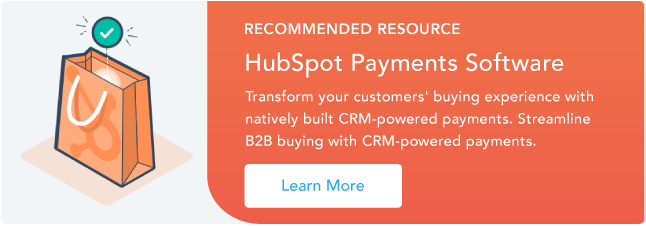Recurring Payments
With recurring payments, a customer provides their billing information once, and then you charge them based on a cadence that you both agreed to.
Subscription Payments
Recurring and subscription payments are terms that are often used interchangeably — that's because recurring payments are how you manage subscriptions.
Subscription payments are when someone subscribes to your product or service and is then billed at a regular cadence.
Benefits of Recurring Payments
Recurring payments can be helpful for your business and your customers. They...
- Save time for customers so they don't have to manually log into a system and enter credit card or bank account details — or write a check — in order to make a payment.
- Ensure your business is getting paid on time and customers aren't having to set payment reminders.
- Help your business predict cash flow.
- Allow you to retain more customers.
- Keep a single record of all payments a customer has completed and/or owes.
- Can automate the entire recurring payment process (if you implement a recurring payment tool).
What types of businesses can benefit from recurring payments?
Any business that offers a product or service that requires a subscription can benefit from recurring payments. For example, businesses that sell services and/or non-tangible goods such as software or a gym membership. Specifically if you sell e-commerce or on a platform like Whop, recurring payments can be a huge time saver. The same goes for businesses like Eversource that charge for utility usage.
An example of a business that sells a tangible product and could benefit from recurring payments is a meal prep delivery service like HelloFresh.
Recurring Payment Processing
You might be wondering how recurring payment processing works. Let's take a look at how you can process recurring payments next.
Accept Recurring Payments
To accept and process recurring payments, start by selecting a recurring online payment software.
Then, provide your customer with the ability to select a payment plan and schedule, as well as their preferred payment method (platform like PayPal, credit card, bank account). Your tool of choice will safely store your customer's billing and payment details.
Then, once it's time for payment, the tool will automatically bill the customer and issue them an invoice.
Here are a few of the best recurring payment processing tools.
1. HubSpot payments
Get started with the Payments tool
Best recurring payments tool for: Businesses that sell services and want to manage subscription memberships as well as integrate payments with their CRM.
Price: Credit and debit cards: You pay a flat 2.9% of the transaction amount. ACH payments: you pay 0.5% of the transaction amount, capped at $10 per transaction
Key features and benefits:
- Ideal for businesses that sell services (such as agencies or financial institutions) rather than tangible objects and need to manage subscription memberships.
- Send a quote to a customer with a recurring payment link and they can then transact in that exact moment.
- HubSpot also provides a seamless customer experience by integrating with your CRM — meaning you can offer personalized buying experiences and streamlined payment all with connected data. For example, you can take one look at a customer profile and determine that they're up for renewal. Then, you can easily get Marketing involved so they can quickly nurture the customer wherever they are in their journey in a personalized.
2. Chargebee
 Best recurring payments tool for: Offering multiple payment methods in various currencies and automatically rectifying any recurring payment failures.
Best recurring payments tool for: Offering multiple payment methods in various currencies and automatically rectifying any recurring payment failures.
Price: You can get started for free and/or schedule a demo.
Key features and benefits:
- Set up a payment card industry (PCI)-compliant payment experience for your customers as well as offer your customers over 23 different payment gateways.
- Offer pricing and recurring billing in over 100 currencies and payment methods if you have an international customer base. There's also a payment dunning feature to help you collect recurring payments even after one-time failures.
3. Wave
 Best recurring payments tool for: Setting up manual and automatic recurring payments at a small business.
Best recurring payments tool for: Setting up manual and automatic recurring payments at a small business.
Price: 2.9% + 30¢ per transaction for Visa, Mastercard, Discover; 3.4% + 30¢ per transaction for American Express; Bank payments (ACH) 1% per transaction ($1 minimum fee).
Key features and benefits:
- Set up a customer's credit card details and then switch between automatic and manual payments depending on which type of billing method is preferable.
- Automatically send your customer a receipt when auto-payment is on — when the feature is off, the tool will send your customer an invoice.
- Drag-and-drop editor makes setting up recurring billing and creating invoices fast. With Wave, you can also customize invoices with your branding, logo, messages, date, and time zone.
4. Recurly

Best recurring payments tool for: Global, recurring revenue companies.
Price: Plans starting at $149/mo + 0.9% of revenue.
Key features and benefits:
- Automate the process of billing and invoicing no matter which of your product/ service and payment plans a customer uses.
- Personalize invoices with your recipient's information as well as your company's branding. Additionally, automate invoice creation and delivery, and manage one-time invoice changes, refunds, credits, and more with ease.
- Helps you with taxes to ensure you comply with all local and global standards.
5. Square

Best recurring payments tool for: Businesses that already use Square Invoices or want to send free invoices and set up annually, monthly, weekly, or daily recurring payments.
Price: Invoices are free to send. If customers pay online with a credit or debit card, then you pay 2.9% + 30¢ per invoice. If customers have you store their card, you pay 3.5% + 15¢.
Key features and benefits:
- Set up recurring payments that bill your customers annually, monthly, weekly, or daily. With Square, invoices are free to send — you pay a processing rate when they're paid online.
- You'll be paid automatically and as often as you and your customer have decided upon if your customers provide their payment details.
- Send automated emails to your customers for recurring payments or print invoices and send physical copies, depending on what's preferable.
Wrap Up
Recurring payments ensure on-time payment for both your business and customers. They make the lives of your customers easier while also saving your team time and improving customer loyalty.
Payments


.jpg?width=3654&name=Create%20a%20Payment%20Link%20-%20Line%20items%20(billing%20frequency).jpg)



![All Types of Payment Methods Business Owners Need to Know [+Data]](https://53.fs1.hubspotusercontent-na1.net/hubfs/53/typesofpayment.webp)
.webp)

![ACH API: What it is + How to Use it [+ Who Should Not]](https://53.fs1.hubspotusercontent-na1.net/hubfs/53/ach-api.jpg)
![What is ACH credit [+ Is It Safe to Use?]](https://53.fs1.hubspotusercontent-na1.net/hubfs/53/what-is-ach-credit.jpg)


